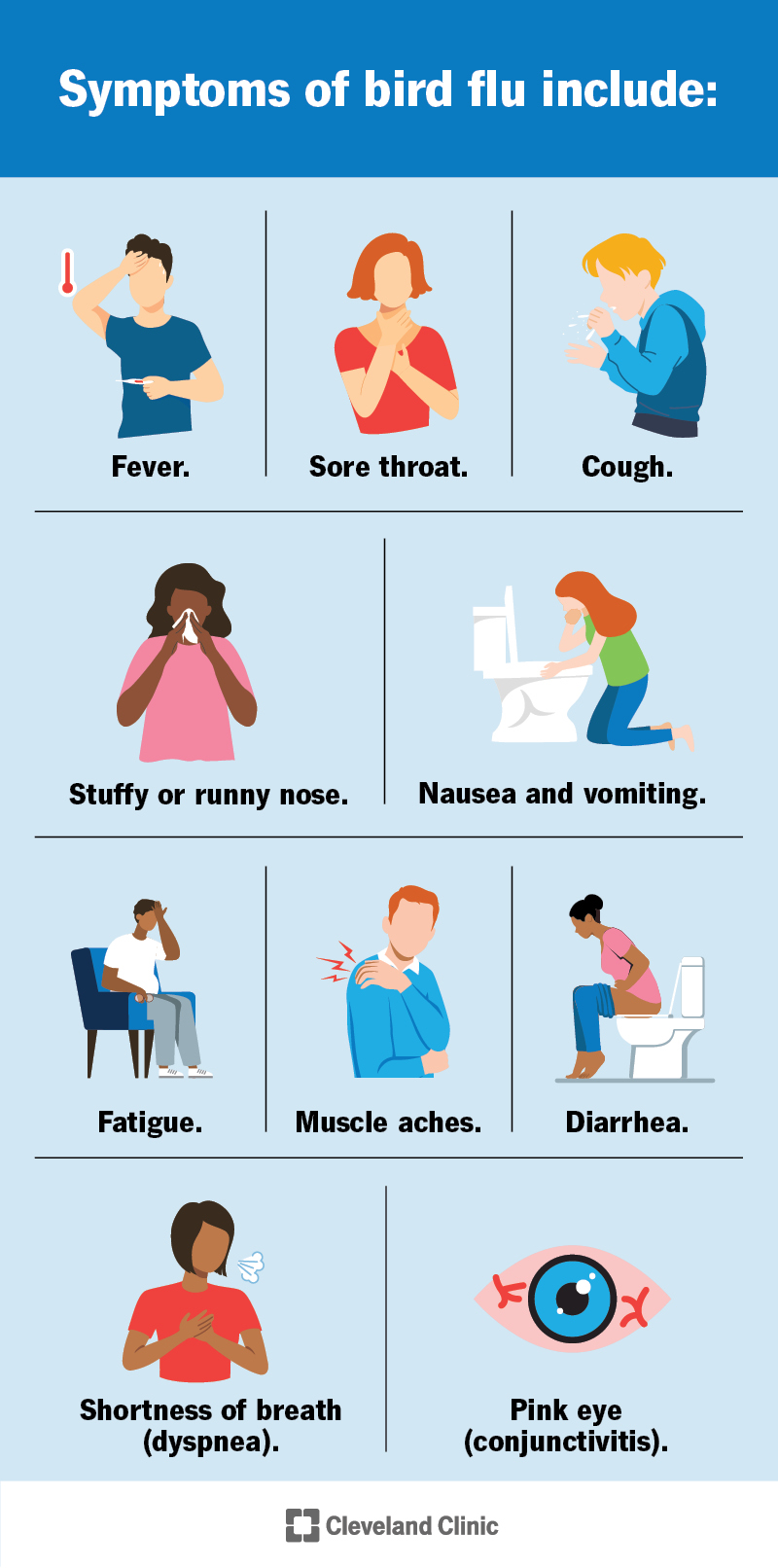Avian influenza, commonly called “bird flu,” is a viral infection that spreads in birds, cows and other animals. It can sometimes spread to people. In humans, H5 subtypes of influenza A are the most common cause. It can cause mild to severe respiratory symptoms and pink eye. People who work with poultry, waterfowl and dairy cows are most at risk.
Advertisement
Cleveland Clinic is a non-profit academic medical center. Advertising on our site helps support our mission. We do not endorse non-Cleveland Clinic products or services. Policy

Bird flu (avian influenza) is an infection from a type of influenza (flu) virus that usually spreads in birds and other animals. Sometimes, humans can get bird flu from infected animals. Like the versions of flu that people usually get, bird flu can make you severely ill. It’s extremely rare for it to spread from person to person.
Advertisement
Cleveland Clinic is a non-profit academic medical center. Advertising on our site helps support our mission. We do not endorse non-Cleveland Clinic products or services. Policy
You might hear about bird flu when there’s an outbreak affecting large numbers of birds or other animals. This is concerning because it increases the risk of human infection, can affect wildlife and can reduce the food supply. There have been ongoing cases of human infections in the U.S. since 2024.
There are many subtypes of avian flu. The recent cases in humans in the U.S. are influenza A(H5). The most common subtypes that have spread to humans in the past have been influenza A(H5N1) and influenza A(H7N9). The types of proteins on the surface of the virus determine the names of these subtypes.
Symptoms of bird flu include:
These symptoms can be mild or severe. Most recent cases of bird flu in the U.S. have caused pink eye and mild respiratory symptoms.
A type of influenza A virus, often H5N1 in humans, causes bird flu. The virus can infect your upper respiratory tract and lungs, and sometimes spread to other parts of your body like your brain.
Humans can get bird flu if they come in contact with an infected animal’s body fluid, like spit (saliva), milk, respiratory droplets or poop (feces). You can breathe it in from small dust particles in animal habitats or get it into your eyes, nose or mouth after touching body fluids.
Advertisement
You don’t get bird flu from eating properly cooked poultry or eggs or from drinking pasteurized milk. Any flocks known to have avian flu virus are immediately taken out of the human food supply.
Bird flu is very rarely contagious (spread from person to person), but there have been a few cases of spread between humans. None of these happened in the U.S. In almost all cases so far, human bird flu infections have come from contact with infected animals. But any time a human is infected, it’s possible that the virus could mutate to spread easily to other humans.
People who work with poultry, waterfowl (like ducks or geese) and dairy cows are at the highest risk for bird flu.
Bird flu can often cause severe illness. Complications include:
Healthcare providers can diagnose avian flu with a throat or nose swab or a swab from the conjunctiva of your eye. Current tests will detect highly pathogenic H5N1 (bird flu) as influenza A. Labs don’t routinely test all positive influenza A swabs for avian flu, so you have to let your provider know that you’ve been in contact with birds, cows or other animals that could be infected. Then, if the test is positive for influenza A, the lab will send the sample to a special lab to be tested for bird flu.
If identified early, you can treat bird flu with antiviral medications. A provider might prescribe:
Some people with bird flu only have mild symptoms, or even no symptoms at all. If you get severely ill, you’ll need to stay in the hospital so a healthcare team can monitor your symptoms and treat you for complications right away.
Overall, the mortality (death) rate for bird flu in humans is high — historically, about half of all people with known infections have died. But most recent cases in the U.S. have been mild.
If you’re at a higher risk for avian influenza, talk to your provider about prevention and when you should seek care if you have symptoms. See a provider if you think you’ve been exposed to bird flu.
Go to the nearest emergency room if you have symptoms of severe illness, including:
It might be helpful to ask your provider:
Ways to reduce your risk of bird flu include:
Advertisement
Public health authorities — like the Centers for Disease Control and Prevention (CDC) in the U.S. — monitor cases of bird flu in animals and people to try to reduce the risk of spread. Scientists are working to develop vaccines that could help prevent avian flu or reduce its severity. These could be put into use if there were a risk of a large outbreak.
Advertisement
Bird flu spreads in birds, cows and other mammals. It sometimes spreads from animals to people. This is a problem for wildlife health, food supply and human health.
It’s possible. If a version of bird flu had a gene mutation that allowed it to spread easily between people, it could cause a pandemic.
Cattle and other animals get bird flu in the same way that humans can get it — through breathing in the virus from contaminated dust in animal habitats or direct contact with body fluids of infected animals.
You might be alarmed when you see headlines about bird flu. While it’s still uncommon in humans, it’s true that some people are at a higher risk for infection, especially those who work around dairy cows, birds or other animals that can carry it. But there are ways to reduce your risks. Talk to a healthcare provider if you have concerns about bird flu.
Advertisement
Need care fast? Cleveland Clinic’s Express Care and Urgent Care locations treat everything from sprains to sinus infections — no appointment needed.

Last reviewed on 12/05/2024.
Learn more about the Health Library and our editorial process.